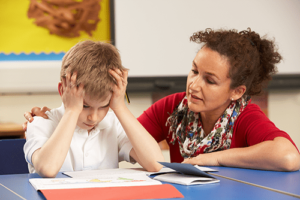Student Contributor: L. Witmer
 Although it is often easy to get frustrated when attempting to redirect students that have gotten off task, it is important to remember that raising one’s voice or losing one’s composure is unlikely to help make the corrective process a positive experience. By staying calm and using a quiet tone of voice, redirection can be accomplished in a more constructive manner.
Although it is often easy to get frustrated when attempting to redirect students that have gotten off task, it is important to remember that raising one’s voice or losing one’s composure is unlikely to help make the corrective process a positive experience. By staying calm and using a quiet tone of voice, redirection can be accomplished in a more constructive manner.
Teacher voice should be used in pretty much any situation that requires some form of redirection/correction. In an ever-dynamic setting like that of a classroom, the ability to remain calm and respectful is key. Speaking in a quiet tone helps bring students back down to earth instead of causing their behavior to escalate further as might occur if the teacher raises their voice (even unintentionally). Additionally, students’ actions should be discussed in a civil way that makes it clear that the teacher’s goal in correcting their behavior is to help them because they genuinely care about their wellbeing. Students are more likely to benefit from corrective measures if mutual respect exists between them and their teacher. Another component of Teacher Voice is to remain non-confrontational with the tone so that a discussion about behavior does not turn into an argument. Staying positive will help de-escalate the situation, which makes restitution/redirection easier to accomplish.
 I have chosen to categorize this tool as a Corrective Phase item due to the fact that I have discussed it in a context that most largely applies to behavior redirection. Teacher Voice could potentially be used for the other phases as well, since remaining composed and respectful is something that you should be attempting to implement during all your interactions with students and not just when dealing with behavioral issues. Although Teacher Voice could probably fit with any of the theories of influence, I think it is best suited for student centered and collaborative, as the emphasis on remaining calm and respectful is an offshoot of building strong student-teacher relationships, which more closely aligns with these two forms of influence.
I have chosen to categorize this tool as a Corrective Phase item due to the fact that I have discussed it in a context that most largely applies to behavior redirection. Teacher Voice could potentially be used for the other phases as well, since remaining composed and respectful is something that you should be attempting to implement during all your interactions with students and not just when dealing with behavioral issues. Although Teacher Voice could probably fit with any of the theories of influence, I think it is best suited for student centered and collaborative, as the emphasis on remaining calm and respectful is an offshoot of building strong student-teacher relationships, which more closely aligns with these two forms of influence.
More Information –
Tool Source: This idea was inspired by various class readings and discussions, but I also gained a lot of valuable information from the following website.
https://bit.ly/2alHn71



I used teacher voice in multiple 7th-grade classrooms with each classroom ranging in amounts of 15 to 23 students per class. I used teacher voice with individual students to correct their behavior during class time. Typically, when I used the teacher’s voice is because the student got off task during work time and needed to be redirected to keep working on their assignments. I found that teacher’s voice worked really well with middle schoolers as when they were yelled at they were experiencing fight or flight by either getting angry at the teacher or shut down and refusing to work. However, when nicely spoken to without being shamed in front of the whole class or judged for not working the students were more likely to respond well in return. Out of all of the times I used teacher voice I only had one time where it did not work when redirecting a student and they were having a very rough day, but we used that time to communicate with each other. This is a great corrective strategy, and I will continue to use it.